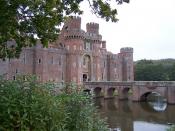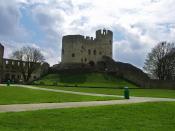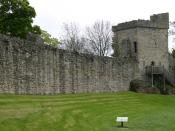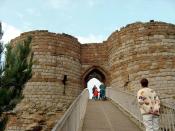The era in which Shakespeare lived is generally considered the ÃÂgolden ageÃÂ in English history. It was a time of great progress in many fields including science, art, technology, and architecture. After the verge of bankruptcy with the downfall of the cotton trade, England had rebounded in the hands of a new queen. There was once again money for things such as the construction of symbols of prominence. One of the most magnificent architectural marvels of this time period that comes to mind is the castle. Its design and structure was perfected over hundreds of years. It required an immense amount of man power which is clearly visible in its cost. Additionally, it provided a strong tactical role in military dominance. Hence, this is what made the castle an awe inspiring creation of itÃÂs time.
The first castles were temporary outposts that provided tactical support. They were generally a single tower made out of wood and provided a height advantage against the enemy.
Unfortunately the choice of building material although cheap and easy to construct meant they were very weak and easily set ablaze. Hence, stone was later used. All castles generally had two elements in common: the keep and the enceinte. The keepÃÂs main function was to serve as the castles command tower. It was used as a secure storage for items such as gold, treasures and important documents. In times of trouble its function was also as a safe house. The second basic component of the castle was the enceinte. Essentially this was a fortified defensive wall that protected a castle from invasion. Flanking towers were usually encompassed into the wall for better protection with the addition of archers. The weakest point of a castleÃÂs defense was the gatehouse. However, over time it was strengthened using removable bridges, more towers, longer passage ways, double gates and arrows (also called murder holes) where projectiles could be fired from.
When constructing a castle, engineers had many fundamentals they need to take into account. The desired location of a castle was on a hill top, therefore giving it a clear view of a surrounding. If possible, a stream would be diverted around the castle creating a moat to prevent siege equipment from access. Engineers also had the problem of making sure a stone quarry was within a reasonable distance from which the massive amount of stone needed could be gathered.
The average sized castle required an estimated 800 stonemasons, 800 craftsmen, 200 quarrymen and as many as 2000minor workmen. It would take years to complete and cost around 30,000 pounds (approximately 40-50 million dollars in todayÃÂs standards).
Sadly, the military purpose of the castles started to decline with the invention of gunpowder. Before the main type of siege machine was generally a throwing kind like the trebuchet, which was defended against by making higher and thicker walls. The use of gunpowder meant cannons were much more accurate and had a devastating power. The new type of weaponry could not be stopped by traditional wall and the old ideals, height and thickness could not withstand the new artillery. A few fortresses were made with short stouter angled walls but its cost didnÃÂt balance with its effectiveness.
Thus, this changed it into the ÃÂpalaceÃÂ style castles; which became higher class residential use and gave it a more aesthetic appearance. Some castles that were not destroyed merged with the towns that sprung up around them creating city walls. In light of the above it is easy to see how architecture of the Elizabethan era was a marvel of human ingenuity and evolved in function and style over time.
http://www.elizabethan-era.org.uk/elizabethan-architecture.htmhttp://www.schools.ash.org.au/immanuel/elizabethan.htmThe architecture of castles : a visual guide, Brown, R. Allen (Reginald Allen), Renouf Publicishing Co. 1984.





